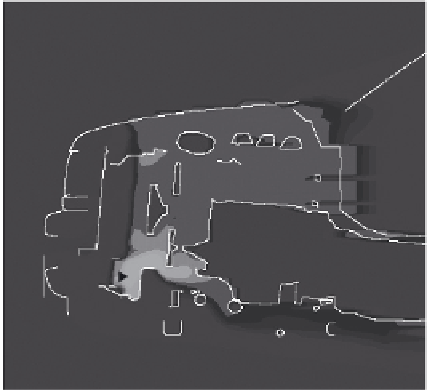Environmental Engineering Reference
In-Depth Information
In Figure 4.56, it is clear that hot locations include those in close proximity to
the engine or radiator (vertical hot zone) plus all zones where air damming is
prominent. For example, on surfaces where airflow is blocked and flow restricted
such as in front of the engine, on the outside surface of air induction components,
between the lower portion of the radiator and front of the engine block and along
the engine compartment bulkhead. Also evident are good package locations such as
up front in the vicinity of the headlamps and also around the cowl top. Packaging of
high replacement cost components in crush zones such as areas immediately behind
the front bumper or headlamps is not recommended. The cowl top area (where the
windshield wiper linkages reside) and in locations above the powertrain in the air
induction component areas also appear benign.
67 °C
80
°
C
43
°
C
92 °C
67 °C
Figure 4.56 Under-hood CFD thermal mapping
Thermal mapping performed using computational fluid dynamics (CFD) is
illustrated in Figure 4.56. It ranges from 6
C (light grey), to 43
C (gray), to 67
C
(medium dark grey), to a high temperature zone of 92
C (dark grey). The high
temperature zone from the lower radiator to front of the engine represents the thermal
load of both engine coolant and air conditioner condenser. The engine compartment
air wash beneath the powertrain is also evident. Air wash beneath the vehicle flows
generally from the driver side to the passenger side due to ram air plus engine cooling
fan patterns. The remaining area to note is the zone in front of the bulkhead and cowl
top. Along the vehicle centreline the temperatures are higher than along the sides
such as by the front shock towers near the cowl top. Typically, this zone is used to
package the vehicle battery and/or electrical power distribution boxes.
Trends in product integration continue to drive actuator power processing to
the actuator itself with control and intelligence located remotely to eventually
becoming distributed in the vehicle's communications and control architecture. At










